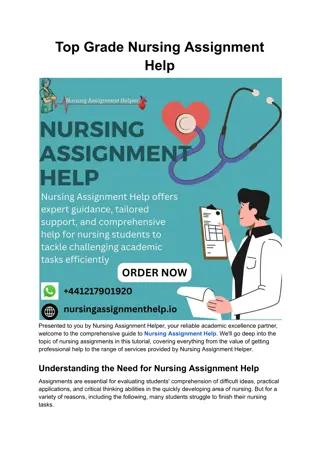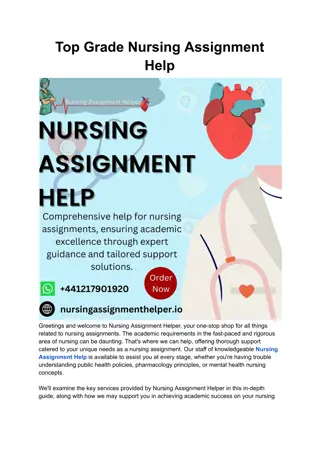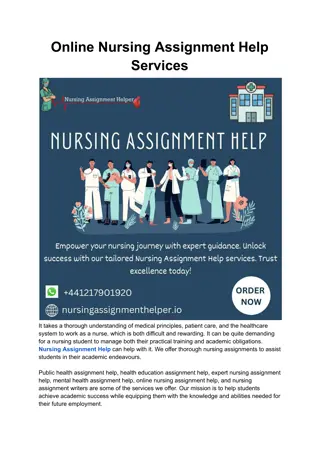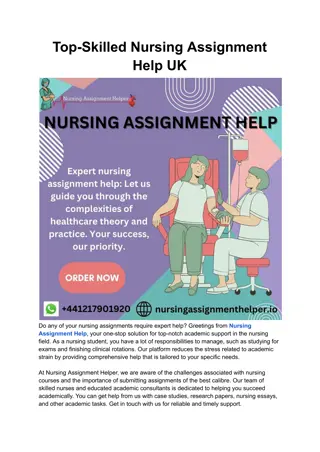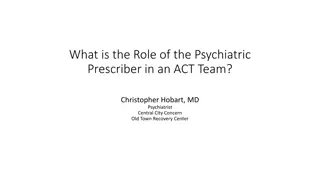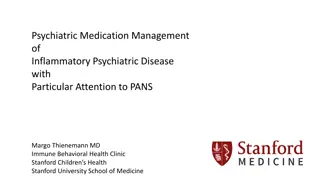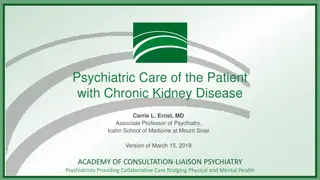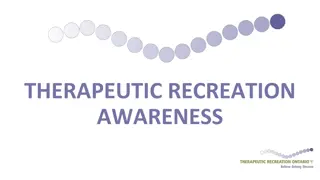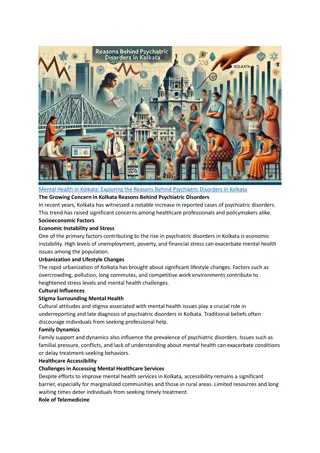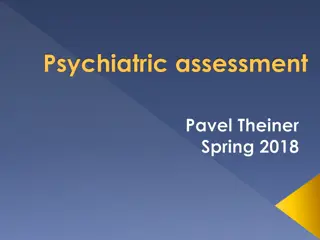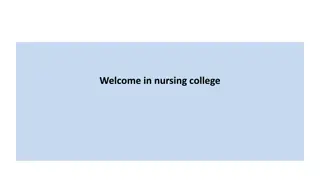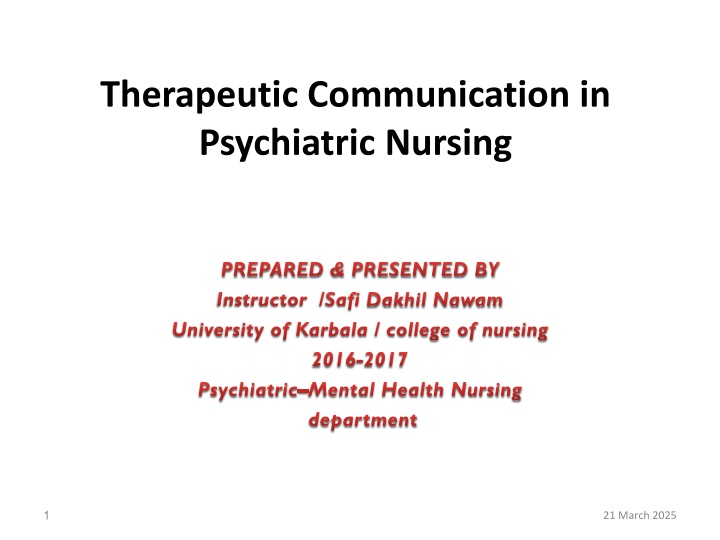
Therapeutic Communication in Psychiatric Nursing - Building Relationships for Mental Health
Learn about the importance of the nurse-client relationship in psychiatric nursing, focusing on therapeutic communication techniques, building trust, and promoting growth. Discover the requirements for a successful therapeutic relationship and the phases involved in the process. Understand the fundamentals of interpersonal communication in mental health care.
Download Presentation

Please find below an Image/Link to download the presentation.
The content on the website is provided AS IS for your information and personal use only. It may not be sold, licensed, or shared on other websites without obtaining consent from the author. If you encounter any issues during the download, it is possible that the publisher has removed the file from their server.
You are allowed to download the files provided on this website for personal or commercial use, subject to the condition that they are used lawfully. All files are the property of their respective owners.
The content on the website is provided AS IS for your information and personal use only. It may not be sold, licensed, or shared on other websites without obtaining consent from the author.
E N D
Presentation Transcript
Therapeutic Communication in Psychiatric Nursing PREPARED & PRESENTED BY Instructor /Safi Dakhil Nawam University of Karbala / college of nursing 2016-2017 Psychiatric Mental Health Nursing department 1 21 March 2025
Introduction The nurse-client relationship is the foundation on which psychiatric nursing is established. The therapeutic interpersonal relationship is the process by which nurses provide care for clients in need of psychosocial intervention. Mental health providers need to know how to gain trust and gather information from the patient, the patient's family, friends and relevant social relations, and to involve them in an effective treatment plan. Therapeutic use of self is the instrument for delivery of care to clients in need of psychosocial intervention. Interpersonal communication techniques are the tools of psychosocial intervention 2 21 March 2025
THERAPEUTIC NURSE-CLIENT RELATIONSHIP Therapeutic directed at learning and growth promotion. Therapeutic Use of Self Definition - therapeutic nurse-client relationship is the ability to use one s personality consciously and in full awareness in an attempt to establish relatedness and to structure nursing interventions. Nurses must possess understanding, and a philosophical belief about life, death, and the overall human condition for effective therapeutic use of self. relationships are goal-oriented and self-awareness, self- 3 21 March 2025
Requirements for Therapeutic Relationship Rapport Trust Respect Genuineness Empathy 4 21 March 2025
Phases of a Therapeutic Nurse-Client Relationship 1. Pre-orientation phase 2. Orientation phase 3. Working phase 4. Termination phase 5 21 March 2025
Interpersonal Communication Interpersonal communication is a transaction between the sender and the receiver. Both persons participate simultaneously. In the transactional model, both participants perceive each other, listen to each other, and simultaneously engage in the process of creating meaning in a relationship, focusing on the patients issues and assisting them learn new coping skills. Both sender and receiver bring certain preexisting conditions to the exchange that influence the intended message and the way in which message is interpreted. 6 21 March 2025
Context of therapeutic communication Values, attitudes, and beliefs. Example: attitudes of prejudice are expressed through negative stereotyping. Culture or religion Cultural mores, norms, ideas, and customs provide the basis for ways of thinking. Social status High-status persons often convey their high-power position with gestures of hands on hips, power dressing, greater height, and more distance when communicating with individuals considered to be of lower social status. Gender Masculine and feminine gestures influence messages conveyed in communication with others. Age or developmental level Example: The influence of developmental level on communication is especially evident during adolescence, with words such as cool, awesome, and others. 7 21 March 2025
The environment Territoriality, density, and distance are aspects of environment that communicate messages. Territoriality - the innate tendency to own space Density - the number of people within a given environmental space Distance - the means by which various cultures use space to communicate 8 21 March 2025
Proxemics: Use of Space Intimate distance - the closest distance that individuals allow between themselves and other Personal distance -the distance for interactions that are personal in nature, such as close conversation with friends Social distance - the distance for conversation with strangers or acquaintances Public distance - the distance for speaking in public or yelling to someone some distance away 9 21 March 2025
Nonverbal Communication: Body Language Components of nonverbal communication Physical appearance and dress Body movement and posture Touch Facial expressions Eye behavior Vocal cues or paralanguage 10 21 March 2025
THERAPEUTIC COMMUNICATION TECHNIQUES Using silence - allows client to take control of the discussion, if he or she so desires Accepting - conveys positive regard Giving recognition - acknowledging, indicating awareness Offering self - making oneself available Giving broad openings - allows client to select the topic Offering general leads - encourages client to continue Placing the event in time or sequence - clarifies the relationship of events in time Making observations - verbalizing what is observed or perceived Encouraging description of perceptions - asking client to verbalize what is being perceived Encouraging comparison - asking client to compare similarities and differences in ideas, experiences, or interpersonal relationships Restating - lets client know whether an expressed statement has or has not been understood Reflecting - directs questions or feelings back to client so that they may be recognized and accepted Focusing - taking notice of a single idea or even a single word Exploring - delving further into a subject, idea, experience, or relationship Seeking clarification and validation - striving to explain what is vague and searching for mutual understanding Presenting reality - clarifying misconceptions that client may be expressing Voicing doubt - expressing uncertainty as to the reality of client s perception Verbalizing the implied - putting into words what client has only implied Attempting to translate words into feelings - putting into words the feelings the client has expressed only indirectly Formulating plan of action - striving to prevent anger or anxiety escalating to unmanageable level when stressor recurs 11 21 March 2025
Therapeutic communication and problem- solving Goals are often achieved through use of the problem-solving model: Identify the client s problem. Promote discussion of desired changes. Discuss alternative strategies for creating changes the client desires to make. Evaluate benefits and consequences of each alternatives. Help client select an alternatives. Encourage client to implement the change. Provide positive feedback for client s attempts to create change. Help client evaluate outcomes of the change and make modifications as required. 12 21 March 2025
LISTENING TO THE PATIENT To listen actively is to be attentive to what client is saying, both verbally and nonverbally. Several nonverbal behaviors have been designed to facilitate attentive listening. S Sit squarely facing the client. O Observe an open posture. L Lean forward toward the client. E Establish eye contact. R Relax. 13 21 March 2025
Process Recordings Written reports of verbal interactions with clients A means for the nurse to analyze the content and pattern of interaction A learning tool for professional development How do I give a patient feedback Feedback is useful when it Is descriptive rather than evaluative and focused on the behavior rather than on the client Is specific rather than general Is directed toward behavior that the client has the capacity to modify imparts information rather than offers advice. 14 21 March 2025
Nontherapeutic Communication Techniques Giving reassurance - may discourage client from further expression of feelings if client believes the feelings will only be downplayed or ridiculed Rejecting - refusing to consider client s ideas or behavior Approving or disapproving - implies that the nurse has the right to pass judgment on the goodness or badness of client s behavior Agreeing or disagreeing - implies that the nurse has the right to pass judgment on whether client s ideas or opinions are right or wrong Giving advice - implies that the nurse knows what is best for client and that client is incapable of any self-direction Probing - pushing for answers to issues the client does not wish to discuss causes client to feel used and valued only for what is shared with the nurse Defending - to defend what client has criticized implies that client has no right to express ideas, opinions, or feelings Requesting an explanation - asking why implies that client must defend his or her behavior or feelings Indicating the existence of an external source of power - encourages client to project blame for his or her thoughts or behaviors on others Belittlingfeelings expressed - causes client to feel insignificant or unimportant Making stereotyped comments, clich s, and trite expressions - these are meaningless in a nurse-client relationship Using denial - blocks discussion with client and avoids helping client identify and explore areas of difficulty Interpreting - results in the therapist s telling client the meaning of his or her experience Introducing an unrelated topic - causes the nurse to take over the direction of the discussion 15 21 March 2025
CONCLUSION Effective communication is the core skill in mental health care in primary care settings. Self-awareness and ability to collaborate with other health care providers are also skills that will facilitate accurate patient's true concerns and the context in which they occur. inquiry into the 16 21 March 2025



